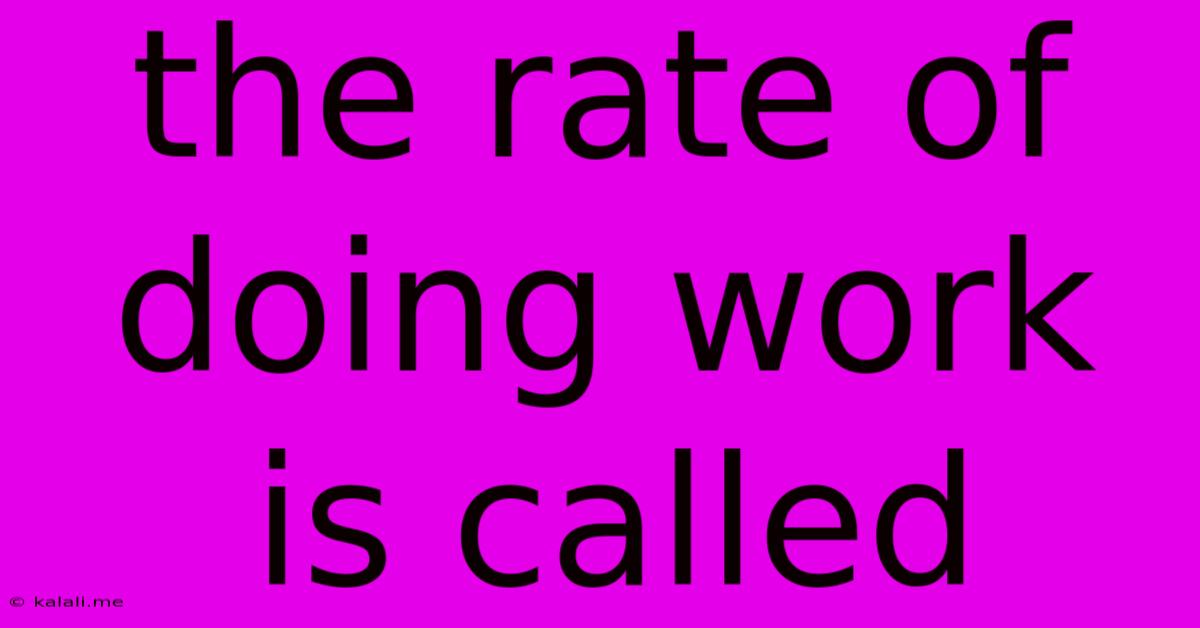The Rate Of Doing Work Is Called
Kalali
Jun 14, 2025 · 3 min read

Table of Contents
The Rate of Doing Work is Called: Power Explained
The rate at which work is done is called power. Understanding power is crucial in physics, engineering, and even everyday life. This article will delve into the concept of power, exploring its definition, units of measurement, and various applications. We'll also discuss related concepts like energy and work to provide a comprehensive understanding.
Power represents how quickly energy is transferred or converted. It's not just about how much work is done, but how fast it's done. Think of two people lifting the same weight: one person might lift it slowly, while the other lifts it quickly. Both do the same amount of work (lifting the weight to the same height), but the person who lifts it faster exhibits greater power.
Understanding Work and Energy
Before diving deeper into power, let's briefly review the related concepts of work and energy.
-
Work: In physics, work is done when a force causes an object to move a certain distance. It's calculated as the product of force and displacement (W = Fd). The unit of work is the joule (J).
-
Energy: Energy is the capacity to do work. It exists in various forms, such as kinetic energy (energy of motion), potential energy (stored energy), and thermal energy (heat). The unit of energy is also the joule (J).
The Power Formula
Power (P) is calculated as the amount of work (W) done divided by the time (t) it takes to do that work:
P = W/t
Alternatively, since work is equal to force multiplied by displacement, the formula can also be expressed as:
P = Fd/t
And since velocity (v) is displacement divided by time (v = d/t), another useful form of the formula is:
P = Fv
This last formula is particularly useful when dealing with constant forces and velocities.
Units of Power
The standard unit of power is the watt (W), named after the Scottish engineer James Watt. One watt is equal to one joule per second (1 W = 1 J/s). Larger units, such as kilowatts (kW) and megawatts (MW), are often used for higher power levels. Horsepower (hp) is another unit of power, commonly used in the context of engines and machinery. One horsepower is approximately equal to 746 watts.
Examples of Power in Action
Power is everywhere! Here are some examples:
- A light bulb: A 60-watt light bulb converts electrical energy into light and heat at a rate of 60 joules per second.
- A car engine: A car engine's power output determines its acceleration and speed. Higher horsepower engines deliver more power.
- A human body: The human body's power output varies depending on the activity. Running up stairs requires significantly more power than walking slowly.
- Hydroelectric power plants: These plants harness the potential energy of water to generate electricity, demonstrating large-scale power generation.
Understanding Power and Efficiency
It's important to understand that power is related to efficiency. A machine or system can be powerful but inefficient. Efficiency refers to how much of the input energy is converted into useful work. A high-efficiency system will waste less energy as heat or other forms of unusable energy.
By understanding the concept of power and its relationship to work and energy, we can better appreciate the rate at which things are done and how efficiently energy is used in various applications. The power equation is a fundamental tool for analyzing and predicting the performance of many physical systems.
Latest Posts
Latest Posts
-
Least Common Multiple Of 4 8 And 12
Jun 15, 2025
-
Difference Between A Square And Rhombus
Jun 15, 2025
-
Unit Weight Of Water In Kg M3
Jun 15, 2025
-
How To Balance Chemical Equations Calculator
Jun 15, 2025
-
Which Of The Following Describes Transpiration
Jun 15, 2025
Related Post
Thank you for visiting our website which covers about The Rate Of Doing Work Is Called . We hope the information provided has been useful to you. Feel free to contact us if you have any questions or need further assistance. See you next time and don't miss to bookmark.